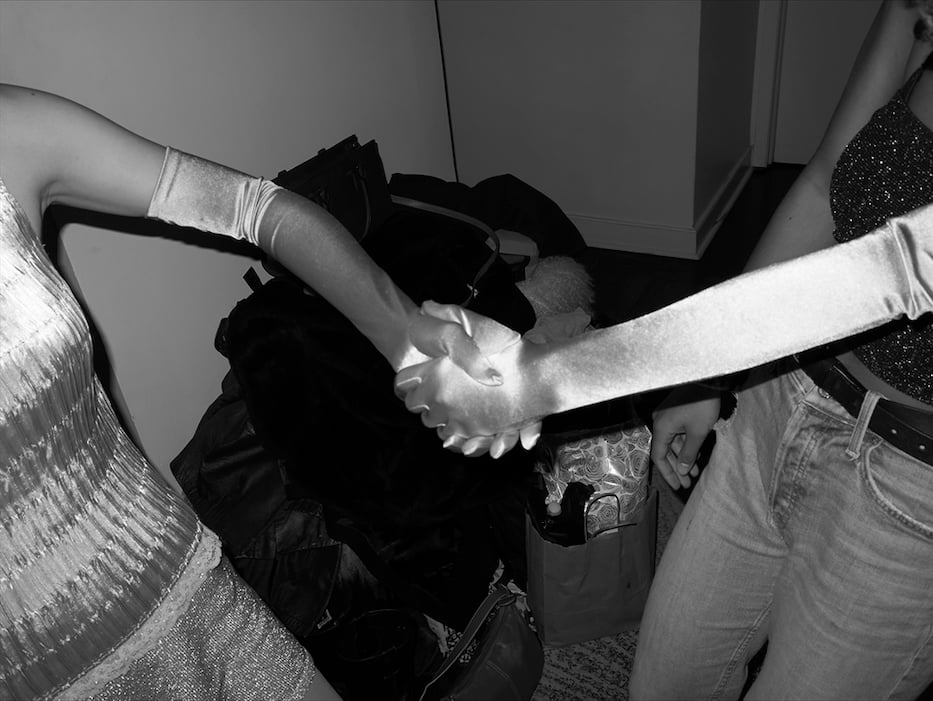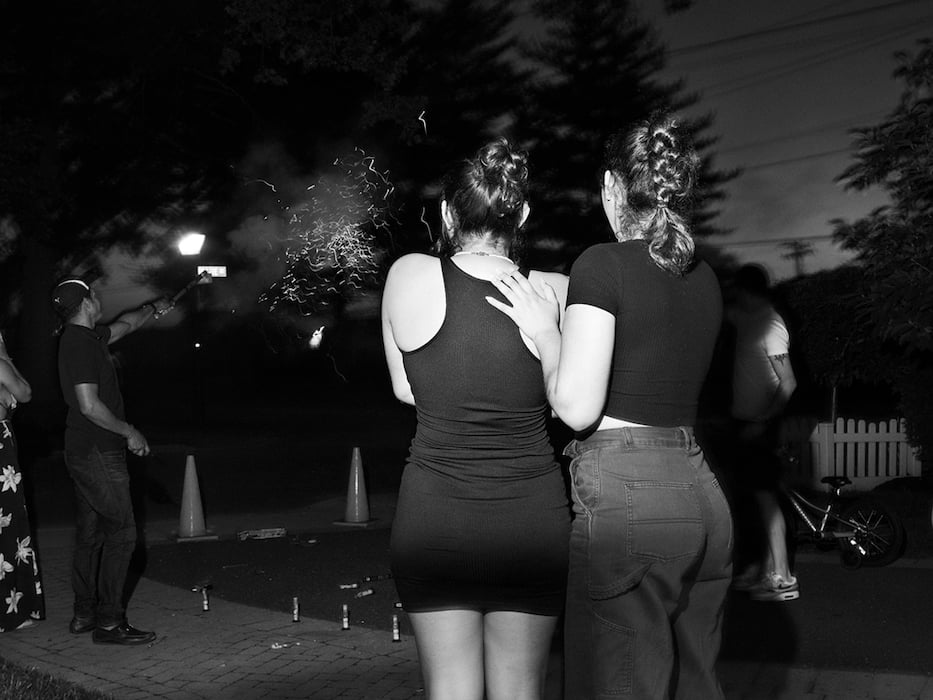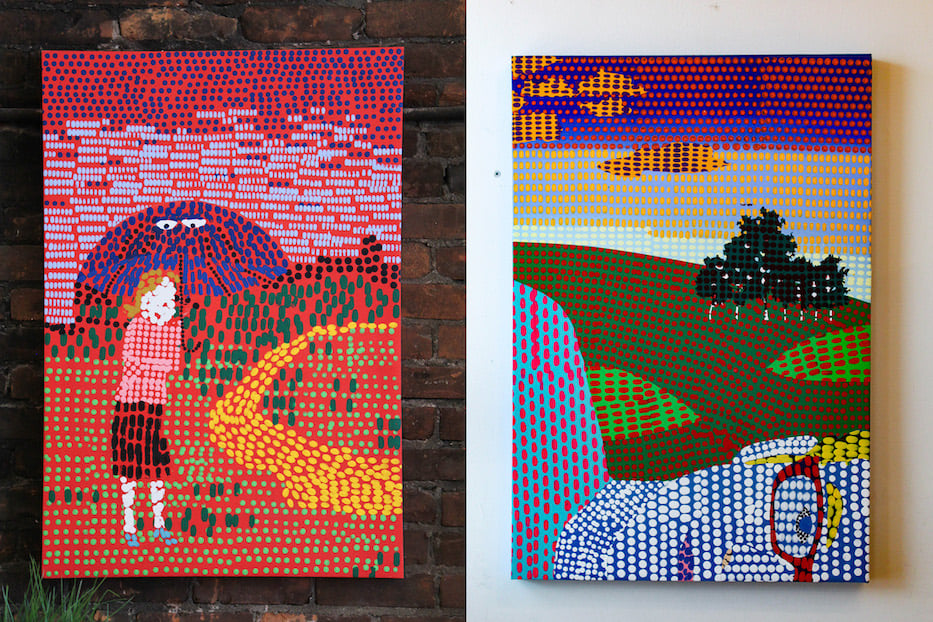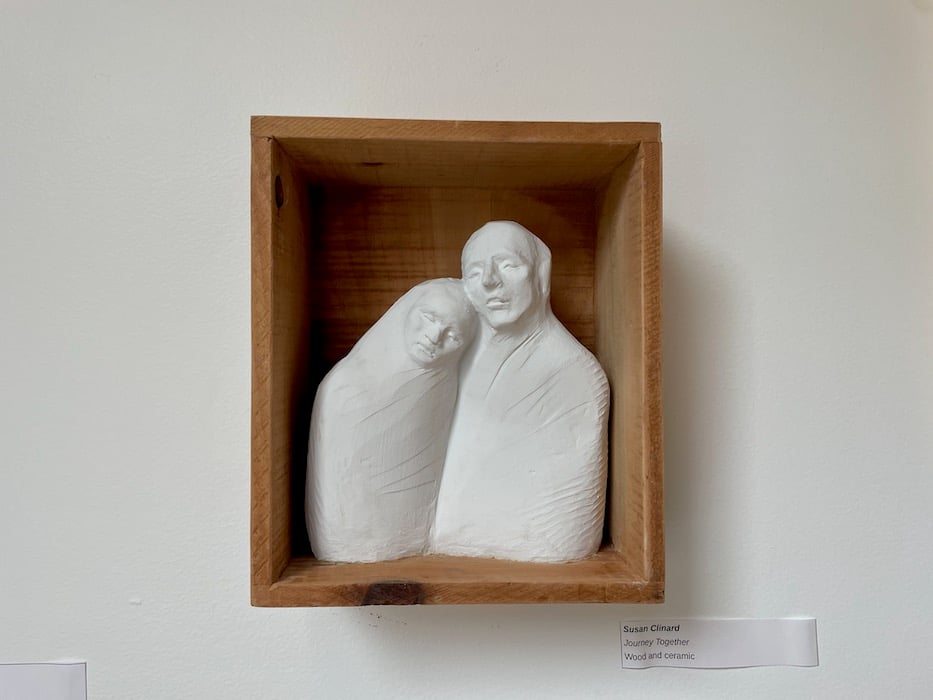

Top: Johan Orellana, Emma and Melissa. Image courtesy Johan Orellana, copyright 2022. Bottom: Johan Orellana, Meylin and Dayana. Image courtesy Johan Orellana, copyright 2021.
In Johan Orellana’s photograph Emma and Melissa, two arms meet in the middle of the frame, hands embracing tightly. Each is sheathed in a long velvet glove that stretches up past the elbow. The gloves—shared between the couple, one apiece— fit snugly. Beneath their iridescent surface, one can almost make out the contours of muscle and bone. The figure on the left (Emma, presumably) wears a shimmery silver dress; Melissa has opted for jeans and a tank top. They dance, swinging in a circle. A large pile of bags stuffed into a corner fills the background of the image. This party is elegant and messy, casual and kitsch.
This photograph is one in a series of Orellana’s images centering intimacy in FUSION, running August 1 to Sept. 29 at the downtown co-working space KNOWN. The show is curated by Omola Studio for Kim Weston’s Wábi Gallery, which is temporarily exhibiting work at KNOWN while its permanent location is under construction. Other locations have included the Mitchell Branch Library and Ely Center of Contemporary Art.
Artists in the exhibition include Saint Phifer, Susan Clinard, Orellana, Jeff Ostergren, MO, and Ronald Ferrucci. While the show is relatively small, the selection is wide-ranging, and includes painting, photography, sculpture, and collage. At times, this expansive scope can come at the cost of coherence, but for curator Mosho ‘MO’ Olagunju, such variance is precisely the point.
“It’s a mix of ideas,” said Olagunju, the founder of Omola Studio, who has several paintings included in the show. “I want the viewer to be able to find something on display that they can resonate with.”

Paintings by Jeff Ostergren. Left: Woman with Parasol (Abilify). Right: Copse in the Head (Blue).
Olagunju noted that while KNOWN is not a typical white-walled gallery—works are installed throughout the hallways and alcoves of the fourth-floor office space—he finds the space conducive to displaying such a variety of art. “One of the tenets of a co-working space is about the crossing of ideas,” he said. In conceiving of FUSION, Olagunju considered “what it would mean to reflect that through an exhibition of a mix of artists across different mediums.”
Four works from New Haven-based painter Jeff Ostergren stand out in particular from this mix. Ostergren’s work, which has been regularly exhibited across Connecticut and featured in several international galleries, examines “the intertwined histories of pharmaceuticals and color.”
In Woman with Parasol (Abilify), a figure in a pink blouse and black skirt stands in the middle of a field. Rain pours down and she appears to shiver—arms wrapped tightly around her torso. Her umbrella, while offering some reprieve from the deluge, is painted with a set of large eyes which glare down at the woman. A yellow path curves off into the distance. Despite the vibrant, saturated colors, the mood is somber.
The composition is based off a scene from a 2012 television commercial for the antipsychotic drug Abilify, which Ostergren has reinscribed in his characteristic “pharma-pointilist” style. A vivid matrix of pill-shaped dots form the scene. Each of these capsules is based on the color, size, and shape of a real medication, and Ostergren physically mixes these medications into his pigments.
The materials list for the painting, cataloged on Ostergren’s website, includes Aricept, Aspirin, Claritin, Lamotrigine, Lunesta, Luvox, Meclizin Hydrochloride, Oxycontin, Pantaprazole, Xanax, and Zoloft. Drugs have long influenced artistic production—perhaps seen most readily in psychedelic art—but Ostergren takes this a step further, physically imbuing his paintings with actual pharmaceuticals.
Beyond Ostergren’s conceptual rigor, the paintings themselves are technically impressive. “I wanted Jeff’s works to be in their own space because I felt like his work really deserves the time to be sat with,” Olagunju said. Standing in front of the modestly sized canvases—each about two by three feet—viewers are forced to reflect on the visual economy of the pharmaceuticals industry.
But one just as easily gets lost in the fantastic textures of Ostergren’s pictures. His repeating rows of lozenges are precise without being rote. They almost look like textiles.

Susan Clinard, Journey Together.
A small, subdued sculpture from Susan Clinard, one of several multimedia works of hers in the show, balances out Ostergren’s colorful scenes. In the piece, entitled Journey Together, two unpainted ceramic busts are held gently by a rough-hewn wooden box. The figures appear exhausted, eyes closed. One leans its head on the other’s shoulder.
Details are sparse—just enough to define the fatigue in their faces and a few wrinkles in their clothes —but there’s a whole story in this small frame. They have stopped to rest, cradled by the timber frame in which they are mounted, and soon they will continue.
“I think the exhibition is really just for art-enjoyers, art-seekers, to come and see the work that is being made in the city,” said Oalgunju. “When I was thinking of FUSION, I thought about how, as individuals, we’re not homogenous.”
Wandering around KNOWN, not every piece will land for everyone. But across all the works, something is sure to stick.